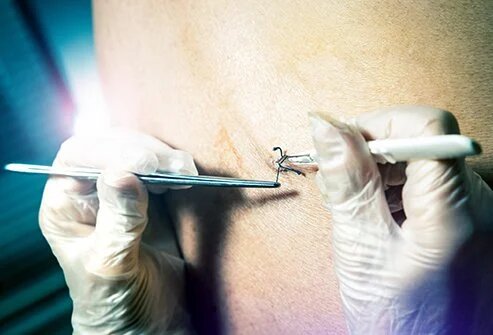- COVID-19 vaccine: Get the latest updates on children’s doses, booster shots and more
Suture Removal
Suture Removal
Suture or surgical Sutures referred to as stitches is sterile surgical wires used to sew body muscles unitedly after a cut, injury or operation.
A suture is a medical tool used by doctors, operators and embalmers to keep the skin, inner organs or blood vessels jointly in the cause of an injury or surgery. Sutures are safe, non-toxic, hypoallergenic and pliable to be used for sewing the body tissues.
There are many types of sutures available with various features. It gets utilised for diverse surgical needs depending upon the tissue stitched together and the period required for the future to be in place. Sutures get chiefly divided into two groups,
Absorbable sutures – The absorbable sutures require non-manual removal and break after a given space into the tissue as the scar heals.

Non-absorbable sutures – The non-absorbable sutures don’t break even after a given duration. They require to be manually extracted by a doctor after the injury or surgery has healed.
Suture wound care includes keeping the injury dry for the first 24 hours. And only after that one can start cleaning it carefully with warm water and liquid solvent at least once a day. The application of an antibiotic cream after washing and drying the bruise to stop a thick scab from growing over the sutures.
What can I anticipate during the suture removal procedure?
You get positioned conveniently so that the area with sutures or staples is easily attainable. The area affected will be cleaned to remove debris and free any scar tissue from forming. Using sterile forceps, the nurse will discreetly pick up the knot of each suture and will cut the suture using a blade.
The appointed nurse will then use the forceps to pull the suture mildly to remove it amply intact. You may feel a petty tugging feeling, but it will not harm you. She will proceed with each suture until all of them get removed. If you have staples, we will use a tool that relates to a wire cutter to grip each in the centre. By pressing the handle, the staple’s edges get bent upwards. And the staple is gently pulled straight up and out. Again, you won’t feel any pain.
Following that, the nurse cleans the bruise. She may apply adhesive bands to hold the wound ends together for a few more days until the bruise has strengthened again. It depends on the extent and position of the scar.
After suture/staple removal
Just because your sutures or staples are out do not mean you are off the sickle as far as wound care works! You still need to:
- Leave the adhesive tapes in place for roughly five days or until they fall off freely.
- Keep your wound dry and tidy.
- Protect your wound from shock for about a month, as your bruise will be delicate and prone to breaking open should you bear an injury in the same place.
- Protect the area from extreme sunlight.
We provide quality and safe at-home healthcare services. So you don’t have to drive to a hospital or clinic for procedures. We have a crew of highly skilled and reliable health professionals ranging from senior doctors, nurses and physical therapists. And other health experts, all trained medically and provided to help a victim. We can also assist you with precise and careful suture removal at your home. So all you need do is give us a call and relax. Our doctor would soon visit you at your place.
